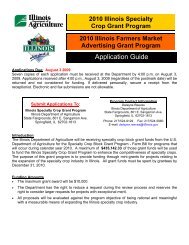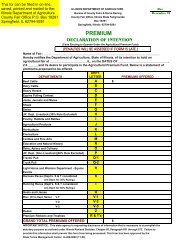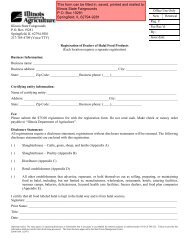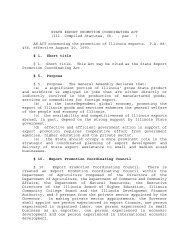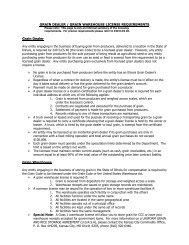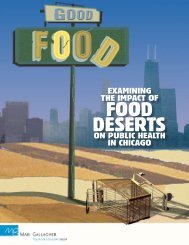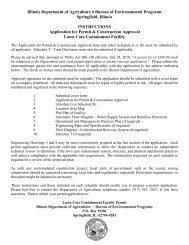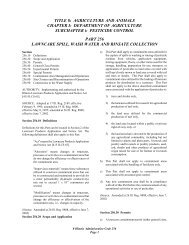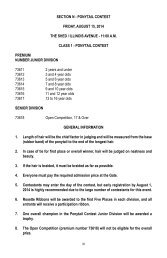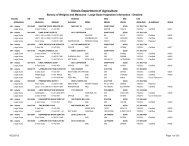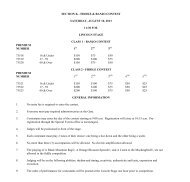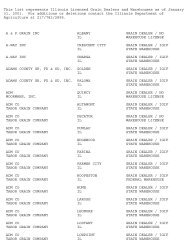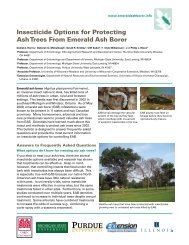Organic Harvest Report - Illinois Department of Agriculture
Organic Harvest Report - Illinois Department of Agriculture
Organic Harvest Report - Illinois Department of Agriculture
Create successful ePaper yourself
Turn your PDF publications into a flip-book with our unique Google optimized e-Paper software.
The Need for <strong>Organic</strong> Farmers<br />
Here’s what the largest buyers <strong>of</strong> organic food in the region say<br />
about demand.<br />
<strong>Organic</strong> Valley<br />
Wisconsin-based <strong>Organic</strong> Valley is the second-largest organic<br />
milk company in the US and they source some <strong>of</strong> their fluid milk<br />
from <strong>Illinois</strong> producers. The demand for organic milk, however,<br />
is much larger than the supply. “<strong>Organic</strong> Valley can’t keep up<br />
with customer requests for organic milk,” says CEO, George<br />
Siemon. “We would sign up 100 new farmers if they were<br />
available. <strong>Illinois</strong> is a great place for us to source milk because<br />
we have established pick-up routes in the state.”<br />
Whole Foods Market<br />
Whole Foods Market has consistently worked with Sustain<br />
and FamilyFarmed.org to increase their purchases <strong>of</strong> local<br />
organic food. “Whole Foods has a strong commitment to<br />
buy products from regional farmers,” says Bobby Turner,<br />
Midwestern Vice President <strong>of</strong> Purchasing. “Our challenge is<br />
finding enough producers with a high enough volume to fit<br />
into our product mix.”<br />
Goodness Greeness<br />
As the second largest US organic produce supplier, Goodness<br />
Greeness buys a lot <strong>of</strong> fresh fruit and vegetables. Recently, in<br />
partnership with FamilyFarmed.org, Goodness Greeness has<br />
increased their local procurement by 500% since 2003. Yet the<br />
company would purchase much more regional food— it simply<br />
lacks supply. “We are actively recruiting regional organic<br />
producers,” says Goodness Greeness CEO, Robert Scaman.<br />
“I wish we didn’t have to work so hard to bring growers on.<br />
It’s hard to believe we don’t have more farmers that want the<br />
substantial price premiums <strong>of</strong>fered in the organic world.”<br />
Demand for <strong>Organic</strong> Corn<br />
and Beans Brings Imports<br />
In recent years, the price for<br />
organic corn and soybeans has<br />
been double, triple or more <strong>of</strong><br />
conventional corn and beans.<br />
Clarkson Grain Company <strong>of</strong> Cerro<br />
Gordo, <strong>Illinois</strong>, is one <strong>of</strong> the world’s<br />
largest organic grain brokers and<br />
purchases many <strong>of</strong> its products<br />
from <strong>Illinois</strong> farmers.<br />
“<strong>Illinois</strong> farmland produces some<br />
<strong>of</strong> the finest organic grains in<br />
the world, and we have many<br />
excellent organic producers,” says<br />
Lynn Clarkson, Clarkson’s CEO.<br />
“Our biggest problem is that we<br />
don’t have enough American<br />
organic grain. As a result,<br />
producers from China and Brazil<br />
are beginning to fulfill the huge<br />
demand.” The Midwest <strong>Organic</strong><br />
Farmers Cooperative is also buying<br />
increasing amounts <strong>of</strong> grain from<br />
regional producers.<br />
“A recent USDA<br />
study estimated that<br />
the United States<br />
imported as much as<br />
$1.5 billion in organic<br />
food in 2002, while<br />
exporting as little as<br />
$125 million worth <strong>of</strong><br />
organic products.”<br />
<strong>Organic</strong> Food Producers Lose<br />
Ground to Imports, (October 8,<br />
2005) Des Moines Register.<br />
7



